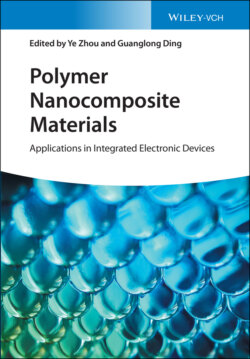Читать книгу Polymer Nanocomposite Materials - Группа авторов - Страница 42
2.4.2 Piezoresistive Sensor
ОглавлениеIn recent years, CPC based pressure sensors as a branch of smart material, which could respond to compressive deformation and transform mechanical forces into electrical signals, have been extensively developed [134]. To meet the demands of different applications, innovated material structures and fabrication strategies are developed to prepare flexible and wearable pressure sensors with excellent sensing performance. CPCs containing an elastic matrix and conductive nanofillers are the most popular candidates of the piezoresistive sensor [135]. Textiles with fiber networks are often used as flexible scaffolds of piezoresistive sensors by carbonization or coating conductive fillers onto the fiber surface [136, 137]. Li et al. [137] fabricated flexible and electrically conductive carbon cotton (CC)/PDMS composites by infiltrating PDMS glue into the CC scaffold. The CC/PDMS demonstrates a sensitivity of 6.04 kPa−1, a working pressure of 700 kPa and durability over 1000 cycles. CPCs with a porous structure (foam, aerogels) are another ideal active materials of piezoresistive sensors because of their highly reversibility and hence reusability after large-deformation cycles [138, 139]. Zhong and coworkers [140] successfully fabricated lightweight MXene (Ti3C2) aerogel with ultra-stable lamellar structure by freeze drying the mixture of bacterial cellulose fiber and MXene nanosheets. The carbon aerogel used for pressure sensor demonstrates ultrahigh compressibility and superelasticity, a wide linear range and low detection limits.
Figure 2.6 (a) Photograph showing the smart glove integrated with the fiber composites. (b, c) Strain sensing behavior of the smart glove for (b) fingers bending and (c) a full bending stimulation of each finger. (d) Photographs showing the hand robot operated by the smart glove. Source: (a)–(d) Reproduced with permission. [111] Copyright 2018, American Chemical Society. Relative resistance change of the sensor responding to various postures: (e) head-forward, (f) shoulder imbalance, and (g) kyphosis, respectively. (h) Photos showing a smart glove incorporated with fiber composite. Strain sensing behavior of the smart glove for (i) different gestures of the five fingers and (j) different bending angels of the wrist. Source: (e)–(j) Reproduced with permission. [114] Copyright 2019, The Royal Society of Chemistry.
To enhance the response intensity and low detection limit, CPCs with delicate structures like fingerprint pattern [141, 142], microdome or micropillar array [143, 144], hair of human skin [145], plant leaves [146, 147], hollow spheres [148], etc. were studied. Park et al. [149] have reported flexible piezoresistive sensor by building interlocked microdome arrays on the elastomer composite film. The flexible film with regular microdome arrays can be observed by SEM as shown in Figure 2.7a. The inset picture demonstrates its excellent flexibility. The schematic diagram (top) and SEM image (bottom) of the fracture surface for the composite films are shown in Figure 2.7b, and an interlocked structure can be observed. The operating principle of the sensing device is also schematically illustrated in Figure 2.7c. Under the stress of external pressure, the microdomes would deform and the contact area between interlocked microdomes was increased, which in turn influenced the tunneling resistance of the sensor. Figure 2.7d shows the pressure sensing performance (relative electrical resistance (R/R0)) of composite film with different structures. The film with interlocked microdomes demonstrates a sharp decrease in R/R0 when the applied pressure increases from 0 to 10 kPa, while the sensing signals for films with single microdome arrays and planar structure are much weaker. Also, the sensing curve (log–log plot) of R/R0 vs. pressure demonstrates a high linearity (Figure 2.7e), indicating an exponential dependence of resistance on the applied pressure.
Bae et al. [144] prepared highly linear and sensitive graphene/PDMS composite films with microdome structures. They found that pressure sensor made of hierarchical graphene/PDMS array with wrinkles on the surface of the microdome was more sensitive to external stimuli than sensor made of smooth-dome graphene/PDMS array. This novel type of pressure sensor exhibits a superb endurance of 10 000 cycles and a low detection limit of 1 Pa.
